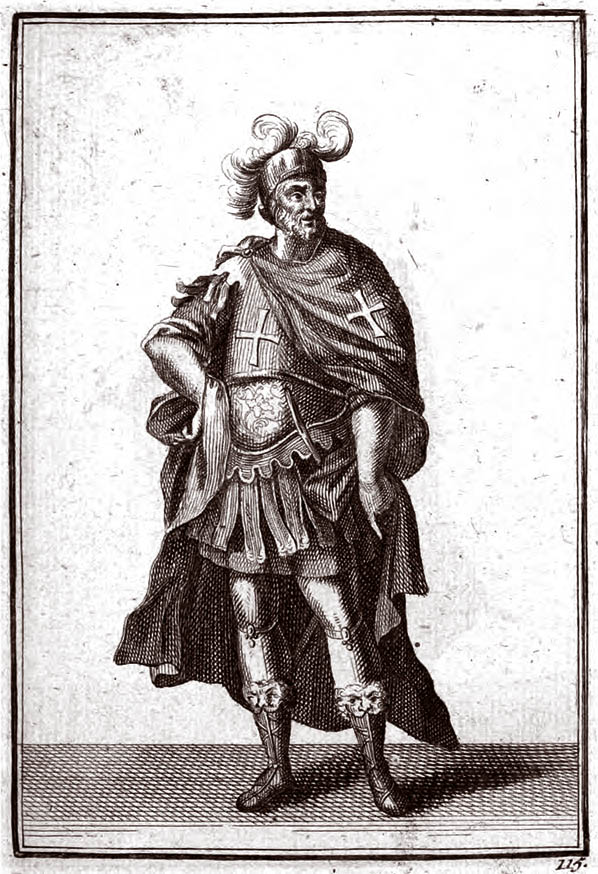Ordinum equestrium et militarium catalogus in imaginibus expositus by Filippo Bonanni (1638-1725). Peter Partner compared this book to a modern day coffee book. It is indeed loaded with illustrations and devoted to a very popular subject: Chivalric orders. During the 18th century, everything that had to do with nobility, heredity and power was of extreme interest to a lot of people who were on the outside looking in — the European bourgeoisie. Filippo Bonanni managed to find the most obscure orders and organizations throughout history (that might be a subject in itself), but his Knight Templar looks rather strange. The armor is almost Roman! The accompanying text is fair and rather sympathetic to the Knights. There is one obvious mistake about the date when the Order received its Rule.
Post bellum sacrum, auspiciis Urbani II. & Godefridi Bullionei commissum, ad ea conservanda, quae feliciter recuperata erant, Hospitalliorum exemplo, Templariorum ordo a Gallis Principibus institutum fuit; Ejus Auctores praecipui fuerunt Hugo de Paganis, & Goufredus a S. Audomato, Equestri ambo dignitate insignes, & quia loco juxta Templum Domini, a Balduino Rege concesso, commorabantur, Fratres Templarii sunt appellati. More Canonicorum Regularium vivebant, & peregrinos per Loca Sancta contra latronum, & Barbarorum insidias ducebant; donec de mandato Honorii Papae, & Stephani Hierosolymitani Patriarchae anno 1118 data fuit eis regula, quam a Bernardo conscriptam affirmant, & alba vestis ex lana, & Eugenii demum Authoritate crux rubra attributa; ut vestes albas in signum innocentiae deferentes, per cruces rubras martyrium ob Christi nomen suscipiendum non dedignaretur, & ad sanguinem efundendum ob terrae Sanctae defensionem essent parati. Narrat Vitriacus in hist. Orient. cap. 65 Vexillum deferri ab illis bipartitum ex albo & nigro colore, eo quod Christi amicis candidi essent & benigni; nigri autem & horriblies inimicis. Crucis tesseram habebant octogonam similem Melitensi. Hieronymus tamen Romanus contendit, suisse duplicem & quasi patriarchalem, qualem exhibemus n. 106. Multis tandem exantlatis laboribus iste ordo Viennae in Concilio Patrum decreto extinctus fuit, & ejus bona Hospitalariis addicta tempore, quo Rhodiorum insulam incolebant. Ejus abolitionis disquisitionem apud Marianam invenies lib. 15. cap. 10. Platinam, Villanum, Azorium & alios. Nos eorum Equitem indumentum in imagine producimus.
The Order of the Templars, following the Hospitallers’ example, was instituted by Frankish leaders after the holy crusade (bellum sacrum), waged under the auspices of Pope Urban II and Godfrey of Bouillon, for the sake of preserving that which had been happily recovered. Its originators were Hugues de Payens and Geoffroy de St. Omer, both knights of outstanding rank. Because they were dwelling in a place adjacent to the Temple of the Lord, at the permission of King Baldwin, they received the name of Templar Brothers. They lived in a manner of regular canons and guided pilgrims to holy sites, avoiding the snares of thieves and barbarians, until by the mandate of Pope Honorius and Stephanus, Patriarch of Jerusalem, in the year 1118 they were given a Rule, said to be composed by Bernard <de Clairvaux>, as well as white woolen vestments, and finally, by the authority of Pope Eugene, they received the red cross as a distinction; so that wearing white clothing as a sign of purity, they would not refuse to accept martyrdom for the name of Christ on the account of the red crosses, and would be prepared to spill their blood for the defense of the Holy Land. <Jacques> de Vitry in his “History of the East”, chap. 65 relates that they carried a two-colored banner of black and white, because they were radiant and kind with the friends of Christ, but dark and horrifying towards his enemies. The had a square eight-cornered cross, similar to the Maltese cross. However, Hieronymus Romanus argues that theirs was a double cross, similar to the Patriarchal cross, which we show under number 106. In the end, after enduring much hardship, this Order was destroyed by decree of the Council of Vienne, and its possessions were awarded to the Hospitallers, at the time residing in Rhodes. You can find a discussion about their dissolution in <Juan de> Mariana, <Bartolomeo> Platina, Giovanni Villani, Johannes Azorius and others. We publish an engraving of such a Knight in full garment.
P.S. I would just like to add that it’s always fun trying to figure out obscure bibliographical references in books of this period!

I love Latin and I study it when I can. I have two books on it, and it’s always nice it in print.
Good to hear that. Btw, I am always open to ideas about Latin texts related to the KT that could be published here and translated.